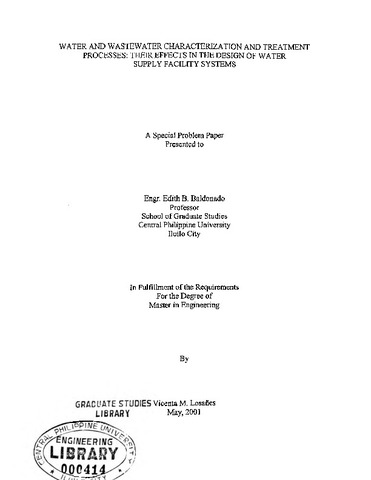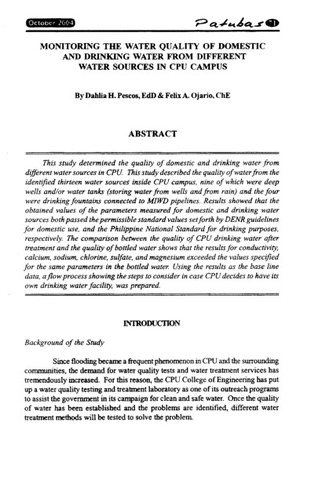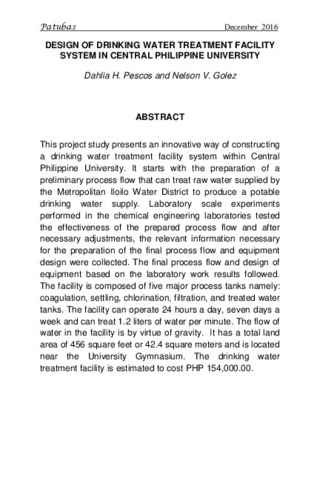Water and wastewater characterization and treatment processes: Their effects in the design of water supply facility systems
| dc.contributor.adviser | Baldonado, Edith B. | |
| dc.contributor.author | Losañes, Vicenta M. | |
| dc.date.accessioned | 2021-10-05T05:50:20Z | |
| dc.date.available | 2021-10-05T05:50:20Z | |
| dc.date.issued | 2001 | |
| dc.identifier.citation | Losañes, V. M. (2001). Water and wastewater characterization and treatment processes: Their effects in the design of water supply facility systems (Unpublished Master’s special paper). Central Philippine University, Jaro, Iloilo City. | en_US |
| dc.identifier.uri | https://hdl.handle.net/20.500.12852/1483 | |
| dc.description | Introduction and statement of the problem | en_US |
| dc.description.abstract | Water is man’s most important resource in life. No matter how rich a person is, without water he cannot possibly exist because water is both the least expensive and most essential commodity that man ever uses. Water is also considered the most important aspect of modem society. As the number of people who live together in a community increase, the requirement of a sufficient supply of potable water increases both in quantity and quality. Having water in a community will automatically lead to the production of wastewater which has to be disposed of in a controlled manner in order not to render the surroundings unpleasant and unhealthy. Water pollution problems caused public health requirements and public demand to impose high standards on water supply and wastewater disposal installations of both the government and industry sectors. The professional responsibility for the design, construction, operation, and maintenance of water and wastewater transmission systems and treatment facilities lies primarily with a civil engineer but the service of a chemical engineer is needed. The chemical engineers main concern is the selection of a suitable sequence of processes to satisfy the requirements for the plant. He also helps in the estimation of the capacities required for all major units, channels, pumps and pipeworks and in the definition of control requirements. It is a common knowledge that in designing an efficient water or wastewater facility system, the characteristics of the water and wastewater to be processed must be known. For example, it is necessary to know the amount of oxygen requirement in the treatment stage. In the day-to-day management of a plant, regular testing is essential so that the plant can be altered to accommodate changing loads. Routine test may reveal the need to modify the chemical dosage of chlorine or coagulant, or a process variable. The discharge of effluents should meet the government standards, thus regular sampling and analysis is a must. These are only some aspects in water and wastewater facility projects where a chemical engineer is needed. Today, it is a fact that most chemical engineers are familiar with different water quality tests and different water and wastewater treatment methods but they are not fully aware of the procedure on how each of these tests or methods are conducted, their advantages and disadvantages, the specific point in the process they should be applied, how each of these affect the process design of a water supply or water treatment facility, and lastly, how to be able to select a suitable sequence of processes to satisfy the requirements for the plant. It is because of this reason that the researcher chose to undertake this study to be able to provide the chemical engineer a sufficient theoretical background on his role in a water supply or water treatment facility projects. Statement of the Problem The main objective of this descriptive research is to provide the chemical engineer a sufficient theoretical background on his role in a water supply or water treatment facility projects. Specifically, this study sought to answer the following questions: 1. What are the chemical structure and microbial degradation of waters and wastewaters? 2. What are the general classification of the constituents of wastewater? 3. What microbial species are found in water and wastewater, what microbiological analysis are used to identify them, and what processes are used to eliminate them? 4. How are waters and wastewaters characterized? 5. What are the physical tests involved in the characterization of water and wastewaters? 6. What methods are used to determine the amount of solid materials dissolved or suspended in water samples? 7. What analytical chemical methods are used in water and wastewater treatment? 8. How is organic pollution measured? 9. How can corrosion affect the water piping system and how it is measured and controlled? 10. What pretreatment and preliminary treatment procedures are required for wastewater before actual treatment? 11. What are the biological treatment processes (both aerobic and anaerobic) used for water and wastewater treatment? 12. What are the physical treatment processes involved in water and wastewater treatment? 13. How are sludges treated and disposed in a wastewater facility? 14. How does water and wastewater effluents are disinfected? | en_US |
| dc.format.extent | 123 leaves | en_US |
| dc.language.iso | en | en_US |
| dc.subject.ddc | GSL Theses 620.0072 L896 | en_US |
| dc.subject.lcsh | Water--Purification | en_US |
| dc.subject.lcsh | Sewage | en_US |
| dc.subject.lcsh | Sewage--Purification | en_US |
| dc.subject.lcsh | Water-supply | en_US |
| dc.subject.lcsh | Water--Pollution | en_US |
| dc.subject.lcsh | Sewage--Analysis | en_US |
| dc.subject.lcsh | Water--Analysis | en_US |
| dc.title | Water and wastewater characterization and treatment processes: Their effects in the design of water supply facility systems | en_US |
| dc.type | Special paper | en_US |
| dc.description.bibliographicalreferences | Includes bibliographical references | en_US |
| dc.contributor.chair | David, Fely P. | |
| dc.contributor.department | School of Graduate Studies | en_US |
| dc.description.degree | Master in Engineering | en_US |





